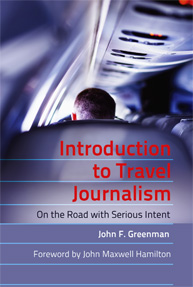Category
Lose the translator
Posted: October 20, 2012 Contents: Chapter 4 | Tags: budget travel, budgettravel.com, melody warnick, translator, travel journalism, travel language, travel technology, travel writing Leave a comment »Chapter 4 advises travelers on how to seek inexpensive but yet effective translators in foreign locations. What if the traveler gets separated or can no longer afford that translator? Not to worry Budget Travel.com’s Melody Warnick offers a few steps of advice that should be able to get the writer through the day.
A few are: Listen to Pronunciation Before you go. And learn key phrases like, “where’s the bathroom and how much does that cost.”
Trying to become fluent in a language for a week of traveling is illogical and not necessary. Learn a few key phrases, download some apps, and ask your concierge or clerk at the hotel for key phrases and pronunciations then go experience.
Add visuals to writing for a more complete story
Posted: October 20, 2012 Contents: Chapter 4 | Tags: photography, rose walker, travel journalism, travel photography, travel research, travel writer, travel writing 1 Comment »Chapter 4 discusses the need for research prior to travel. While the chapter focuses more on writing, Rose Walker offers this advice in Do Your Research to Become a Travel Writer to researching the destination:
“your next step as a travel writer is photography. Most travel writers take photos to go with their articles and most editors want photos. I am sure you have taken pictures while on vacation, but now you want to take professional pictures to sell. Do your research on what editors want in a photo, but most importantly do research on how to photograph pictures to sell.”
Using Walkers advice in addition to Chapter 4 the travel writer should have a complete set of tools to get their writing published along with some stunning visuals.
Avoid jetlag and changing clothes
Posted: October 3, 2012 Contents: Chapter 4, Resources | Tags: avoid common mistakes when traveling, avoid jet lag, budget travel, budgettravel.com, mistakes when traveling, save space when travling, terry ward, travel journalism, travel writing 1 Comment »Budgettravel.com’s Terry Ward offers advice on how to avoid the most common mistakes when traveling, especially when planning a quick getaway. For example, Mistake # 6 – travelers often forget to prepare for a new time zone. Ward suggests:
If it’s already nighttime in your destination when you step on the plane, pass on the in-flight meal and movie and pop in the earplugs for a snooze instead—that way you’ll be waking up with the locals, instead of feeling like it’s time to sleep when you touch down. Plan lots of outdoor activities for your first day in a different time zone, too—the sunlight and fresh air will keep you energized. If there’s no avoiding a snooze, try to limit yourself to a 20-minute power nap.
Ward also lists suggestions like dressing for more than one part of the day as a way to save time and space when traveling….
Know when it’s time to head home
Posted: September 30, 2012 Contents: Chapter 4 | Tags: know when to go home, matador network, matadornetwork.com, spencer klein, travel journalism, travel writing, traveling home Leave a comment »The three-by-three model discussed in Chapter 4 guides the travel journalist through the process of traveling. Included in the process is the preparation to travel, the reporting trip, then writing and publishing. Matador Network author, Spencer Klein, offers advice to readers on the exact opposite: how to know when it’s time to stop traveling and go home.
When the existential satisfaction of open time and nothingness and learning for learning’s sake gives way to distant thoughts and a yearning for routine, that’s a good sign you want to head home.
Some of Klein’s eight signs it’s time to stop traveling and go home include:
You are rationing salted peanuts, you’ve just sold your pocket knife, and last but certainly not least: you’ve agreed to write a copy for the BuenaVista Condo Development marketing brochure.
Writing about home as a destination for others
Posted: September 26, 2012 Contents: Chapter 4 | Tags: backyard, karen gibson, stay home travel, travel journalism, travel writers exchange, travel writing Leave a comment »Chapter 4 offers this advice to journalists who wish to write about destinations but cannot afford either the cost or time it takes to travel: write about your home as a destination. But who wants to read about your boring old town, right? According to Karen Gibson of Travel Writers Exchange, many readers do.
One may think that their own backyard is dull and lacks excitement but, as Gibson points out, chances are people that live on a Caribbean island or in Paris probably don’t think their homes are exotic either. The author advises that travel writers do not have to stick to traditional travel publications as outlets for this work work. Rather, look to other publications about lifestyle, retirement, parenting, and food to diversify outlets and increase the chances to be published.
A new approach to the three-by-three model
Posted: August 25, 2012 Contents: Chapter 4 | Tags: McDonalds, three-by-three model, travel journalism, travel writing 8 Comments »The three-by-three model described in Chapter 4 accomplishes two imperatives for the travel journalist. One is journalistic excellence. The other is journalistic efficiency. In other words, get as much good stuff as possible for the least investment of time and money.
The model proposes that the travel journalist report, write and publish (or prepare to publish) three stories over a three-week cycle. Week One is at-home pre-work. Week Two is the reporting trip. Week Three is back-at-home writing and publishing.
I explored a variant of the model during a recent reporting trip to Prague. I was there to test-drive TOL’s Foreign Correspondent course. The at-home pre-work assignment was to come up with a story idea. Instead of three stories — one sure thing, a story that emerges from serendipity, and a story based on gathering string — as…
